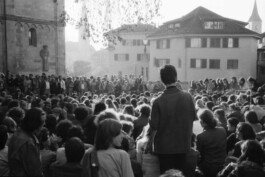René Hammel 1952–(†), 25. Juli 2025
Geboren und aufgewachsen im Zürcher Quartier Heuried/Triemli, wurde René Hammel in den frühen 1970er-Jahren Teil jener wilden Jugendbewegung, die in den Kellern der Stadt nach Gemeinschaft und Gerechtigkeit suchte – etwa im ersten AJZ im Lindenhof-Bunker oder später in den politischen Wohngemeinschaften an der Wiesenstrasse.
In dieser Zeit lernten René Hammel und Jean-Claude Pelli sich kennen – beim Jammen mit E-Bass, E-Gitarre und Klavier, bei politischen Aktionen oder beim heimlichen Abtransport von Chemikalien aus der Firma Givaudan, wo Hammel seine Berufslehre absolvierte. Unter anderem brachte er in linksradikalen Kreisen flüssigen Äther in Umlauf, der für politische Aktionen eingesetzt wurde. Hammel war kein Anführer, aber ein verlässlicher Freund, der mit Leuten wie Pelli unterwegs war.
Unvergessen bleibt seine Rolle in einem der ungewöhnlichsten Kapitel der Geschichte der Zürcher Bewegung: dem Patti-Smith-Konzert 1976 in der Roten Fabrik. Die Nacht begann voller Energie und Poesie – bis Tränengas sie unterbrach. Ausgelöst wurde die Eskalation durch eine Sabotageaktion mit Bromaceton, einer bei Givaudan entwendeten Substanz, die die Augen reizt. Hammel war an der Aktion nicht direkt beteiligt, doch es ist möglich, dass das eingesetzte Bromaceton ursprünglich von ihm stammte.
Zum besseren Verständnis: Die Gruppe aus Hammels Umfeld war ursprünglich nicht auf der Suche nach Tränengas, sondern nach Chemikalien für Molotowcocktails, wie sie 1974 bei der Besetzung der Hegibachhäuser verwendet wurden. Am Morgen des 25. Juli 1974 setzte die Polizei am Hegibachplatz keine Wasserwerfer ein, sondern schloss Feuerwehrschläuche an Hydranten an. Ein Generator sorgte für den nötigen Druck, um mit dem Wasserstrahl die Dächer der besetzten Häuser zu erreichen. Während der koordinierten Aktionen rund um die Häuser gelang es der Gruppe, in Absprache mit den Besetzer:innen auf dem Dach, einen Molotowcocktail in den Generator zu werfen – er ging in Flammen auf. Das Bromaceton war ein Zufallsfund. Man wusste zunächst nicht, wofür es gut war, dachte aber, dass es im Ernstfall – etwa gegen Neonazis – nützlich sein könnte. Dass es schliesslich bei einem Konzert eingesetzt wurde, entsprach weder dem Plan noch dem politischen Anspruch der Beteiligten.

The Who in der Mehrzweckhalle Wetzikon, 5. September 1972. Roger Daltrey, Pete Townshend und Keith Moon. Foto: Rickard Frick.
Jean-Claude Pelli: «Erinnern kann ich mich auch noch daran, dass ich 1972 mit René Hammel am Konzert von The Who in der Mehrzweckhalle Wetzikon war. Dann weiss ich noch mit Sicherheit, dass er an mindestens einer grösseren militanten politischen Aktion in Zürich dabei war: ein Brandanschlag gegen das spanische Fremdenverkehrszentrum an der Seefeldstrasse. Spanien war damals noch eine faschistische Diktatur, General Franco lebte noch. Die Aktion stand im Zusammenhang mit dem offiziellen Staatsbesuch eines spanischen Ministers in der Schweiz, während gleichzeitig in Barcelona der junge Anarchist Salvador Puig Antich zum Tode verurteilt und hingerichtet wurde. 1974 muss das gewesen sein. Puig Antich war der letzte Mensch, der in Spanien mittels Garrotte (Würgeschraube; von Spanisch: «garrote vil», schädlicher Stock) getötet wurde.
René war ein Mensch, der das Leben intensiv erlebte – auch dessen Schattenseiten. Wie viele aus seiner Generation und aus seinem Umfeld hatte er Erfahrungen mit Drogen. Diese gehörten zu seinem Weg, doch sie trugen wohl auch dazu bei, dass sein Leben früh zu Ende ging.
Nach der Schliessung des AJZ sahen wir uns regelmässig in einem Jugendtreff im Heuried. René war nun ziemlich heftig an die Drogen geraten. Das meine ich überhaupt nicht wertend – es gibt sicher Leute, die die gleiche Aussage über mich gemacht hätten. Jeder von uns war mit seinen eigenen Geschichten beschäftigt und verkehrte in anderen Szenen. Die Jahre vergingen und irgendwann erfuhr ich per Zufall, dass René gestorben war. Ein stiller, einsamer Tod und eine sehr einsame, anonyme Bestattung.»

Auf der Fotografie von Olivia Heussler sieht man René Hammel als Teilnehmer der Vollversammlung 1980 vor dem Grossmünster in Zürich. Erschienen im Bildband Zürich, Sommer 1980 bei Edition Patrick Frey.